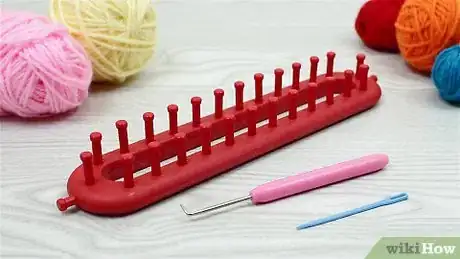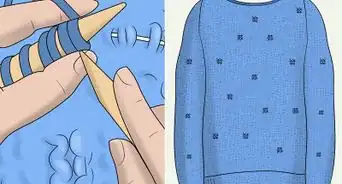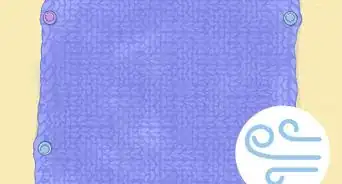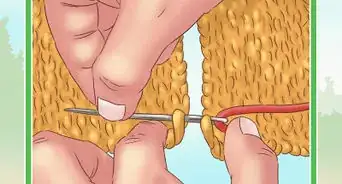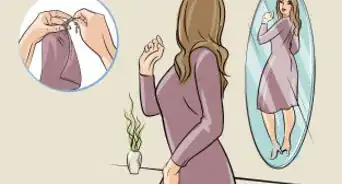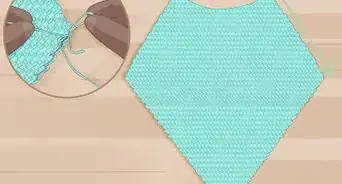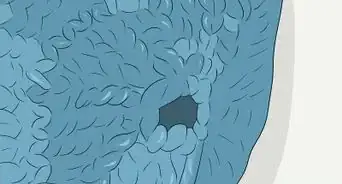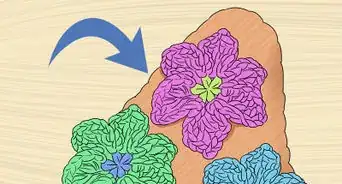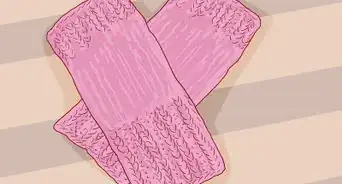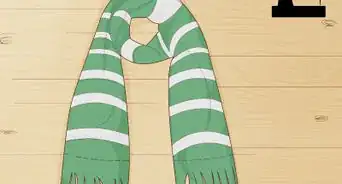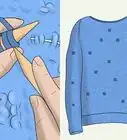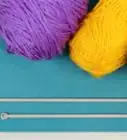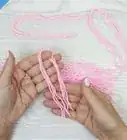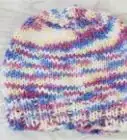This article was co-authored by wikiHow Staff. Our trained team of editors and researchers validate articles for accuracy and comprehensiveness. wikiHow's Content Management Team carefully monitors the work from our editorial staff to ensure that each article is backed by trusted research and meets our high quality standards.
The wikiHow Video Team also followed the article's instructions and verified that they work.
This article has been viewed 94,031 times.
Learn more...
Knitting looms create neat looking garments without the hassle of using knitting needles, counting stitches, and using knitting patterns. You can easily make a scarf with a knitting loom, and it is a great project for beginners. Try making a scarf for yourself or as a gift for a friend!
Steps
Casting Onto the Loom
-
1Collect materials and tools for making the scarf. To knit a scarf on a loom, a few special materials and tools are needed:[1]
- A rectangular loom. 24 peg loom or larger - only the first 24 pegs (top and bottom combined) of any loom will be used. Place the loom on a table or other sturdy surface. This makes weaving a scarf with a loom easier.
- Yarn. Use a super bulky yarn or two strands of medium worsted weight yarn held together.
- Loom tool. This is a hook that comes with the loom. If you do not have a loom tool, use a crochet hook instead.
- Scissors.
- Tapestry or yarn needle.
-
2Make a slipstitch. To start making a scarf on a loom, make a slipstitch. Loop the yarn around the fingers twice, and pull the first loop over the second loop. Keep the loop on the fingers and tighten it by pulling on the tail of the yarn.[2]Advertisement
-
3Tighten the slipstitch around an anchor peg. The anchor peg is on the side with one at each end of a rectangular loom. Loop the slipstitch around this peg and pull the tail to tighten it and hold it in place.[3]
-
4Wrap the yarn around the first peg of the lower row. The lower row is the row closest to you. Enter the loom through the middle, between the two rows of pegs. Wrap the yarn around the inside of the first peg on the lower row of the loom. Bring the yarn clockwise around the outside of the peg and back in towards the center. The yarn should form an upside-down cursive letter “e” around the peg.
- Wrap the peg tightly to maintain tension. This keeps the finished scarf looking neat.
-
5Wrap first peg on the upper row. Bring the yarn up towards first peg in the upper row. Wrap the yarn anticlockwise around the outside of the peg and back in towards the center. A figure eight shape forms between the upper and lower pegs.[4]
-
6Wrap the yarn in a figure eight fashion. Continue wrapping the yarn around the pegs, repeating the sequence used for the first two pegs. Do this until all but the last peg on the upper row is wrapped.[5]
-
7Loop the yarn around last peg in the opposite direction. On the last peg, wrap the yarn around the peg in the opposite direction. Bring the yarn straight up from the bottom peg, and then around the peg.[6]
- Hold end of the yarn taut with fingers.
- This will set up for completing the next round of wrapping.
Working the Loops Off the Loom
-
1Press down on the stitches. Before wrapping in the opposite direction, press down on the yarn between the pegs with the side of the hand. This moves the loops down on the pegs and creates room to loop the yarn around each of the pegs again.[7]
- There should be some resistance when pressing down on the yarn. This indicates good tension, which will result in a neat looking finished scarf. If the yarn feels loose or has already slid to the peg bottom on its own, then the pegs are not wrapped tightly enough. In this case, you may need to start over.
-
2Wrap the yarn around the stitches again. Each peg (except for the last peg wrapped) will need to have two loops on it before working the loops off the loom. To make a second pass, bring the yarn down from the last peg wrapped and around it in the same direction as the yarn from the previous pass. Bring the yarn up to the next peg moving back towards the beginning of the loom.[8]
-
3Loop last peg in the opposite direction. Keep wrapping the yarn around the pegs in the same direction as first round of loops until the last peg (the first peg wrapped on the first pass). Wrap this peg from the opposite direction.[9]
- After wrapping the last peg, hold the yarn in place with fingers or wrap it around the anchor peg on this side of the loom.
-
4Use loom tool to lift bottom loops over top loops. When each peg in the row is wrapped twice (except for last peg on upper end of the loom) begin working the bottom row of loops off the loom. Insert loom tool through the bottom loop on the last peg in lower row. Bring the loop up and over the other loop on the peg to knit it.[10]
- After knitting the first loop on the lower row, repeat for the bottom loop on the upper row. Return to the lower row going back and forth to knit the loops until the end of the row.
- When finished working the first round of loops off the loom, only one stitch is on each of the pegs.
-
5Repeat process to the desired length. Continue the process of wrapping the yarn around the pegs and working back and forth across rows to knit the loops. Continue until scarf is the length desired.[11]
- After a few rows, knit material comes through the bottom of the loom. Measure the knitted material to determine where the scarf will end.
- Four rows creates 1” (2.5 cm) of knit material. For a scarf five feet long or 60” (152 cm), knit about 240 rows on the loom.
Binding Off
-
1Lay the working yarn across the center of the loom. When scarf length is reached, bind it off. Bind off by working from right to left after knitting a row of loops and there is one loop on each peg. Lay the working yarn across the middle of the loom.[12]
-
2Lift stitch off the last upper peg. With loom tool, lift the loop off of the upper peg. Keep this loop on the loom tool.[13]
- A crochet hook can be used for this part. This can be easier than using the loom tool because the crochet hook has a curved end.
-
3Lift stitch off the last lower peg with loom tool. Bring loom tool with upper peg loop still on it over to the lower peg. Lift the loop off from the lower peg and onto the tool. Two loops are on the loom tool or hook.[14]
-
4Move the upper peg stitch. With finger, bring the upper peg stitch over the lower peg stitch. Slide upper peg stitch off of the end of the tool or hook. Only one loop is on the hook.[15]
- One or both of the loops can slide off the hook if using the loom tool for this part, which is why using a crochet hook is easier.
-
5Work back and forth to bind off the entire row. After knitting the first loop, go to the next peg on the upper row and pick up the loop onto the tool or hook. Slide the first loop over the second loop again.[16]
- Bind off loops in this fashion until the end of the loom is reached.
-
6Pull the working yarn through the last loop. At the end of the row the last loop from the loom is knitted. Loop the working yarn around the loom tool or hook and pull it through the second loop on the tool or hook. Pull to create a large loop and cut the loop in the center. Remove the loose yarn and pull the tail to secure the end of the scarf.
-
7Weave in the ends. After creating the end tail, weave it into the end of the scarf to hide it and secure it. Thread the yarn through the eye of a tapestry or yarn needle. Use the needle to weave the yarn through the edge of the scarf. Bring the yarn through each of the stitches on the end of the scarf pulling the yarn taut each time.
- When the yarn cannot be woven any more, then tie off the yarn and cut off the excess.
Community Q&A
-
QuestionIs this any different from knitting a hat with a loom?
 LokiCommunity AnswerYou use a circular loom instead of a rectangular one, and there are different knitting techniques depending on which patterns you want to use.
LokiCommunity AnswerYou use a circular loom instead of a rectangular one, and there are different knitting techniques depending on which patterns you want to use. -
QuestionIf I have no yarn, can I use thick XXL wool?
 T. ChinsenTop AnswererAny yarn type can be used to make a scarf. Constructing a scarf with XXL yarn on a loom can work only if the loom has enough space to fit the yarn around the pegs. It will not knit over the peg if the strand completely fills the space between the pegs.
T. ChinsenTop AnswererAny yarn type can be used to make a scarf. Constructing a scarf with XXL yarn on a loom can work only if the loom has enough space to fit the yarn around the pegs. It will not knit over the peg if the strand completely fills the space between the pegs.
Things You’ll Need
- Rectangular loom with 24 pegs or more
- Yarn
- Loom tool or crochet hook
- Scissors
- Tapestry needle or yarn needle
References
- ↑ https://www.youtube.com/watch?v=UU_sxq6aH44
- ↑ https://www.youtube.com/watch?v=UU_sxq6aH44
- ↑ https://www.youtube.com/watch?v=UU_sxq6aH44
- ↑ https://www.youtube.com/watch?v=UU_sxq6aH44
- ↑ https://www.youtube.com/watch?v=UU_sxq6aH44
- ↑ https://www.youtube.com/watch?v=UU_sxq6aH44
- ↑ https://www.youtube.com/watch?v=UU_sxq6aH44
- ↑ https://www.youtube.com/watch?v=UU_sxq6aH44
- ↑ https://www.youtube.com/watch?v=UU_sxq6aH44
- ↑ https://www.youtube.com/watch?v=UU_sxq6aH44
- ↑ https://www.youtube.com/watch?v=UU_sxq6aH44
- ↑ https://www.youtube.com/watch?v=UU_sxq6aH44
- ↑ https://www.youtube.com/watch?v=UU_sxq6aH44
- ↑ https://www.youtube.com/watch?v=UU_sxq6aH44
- ↑ https://www.youtube.com/watch?v=UU_sxq6aH44
- ↑ https://www.youtube.com/watch?v=UU_sxq6aH44
About This Article
If you want to knit a scarf on a loom, cast on your yarn by wrapping it around the inside of the first peg on the lower row. Bring the yarn around the outside and back towards the center, then wrap the yarn around the first peg on the upper row, starting on the inside so it forms a figure eight. Wrap the yarn around the pegs in figures of eight until you get to the last one on the top row, which you should loop in the opposite direction. Repeat this process once, then use a loom tool to lift the bottom loops over the top loops. Continue to wrap the pegs with yarn and lift the loops until your scarf is the right length. To find out how to bind off when you're done, read on!
